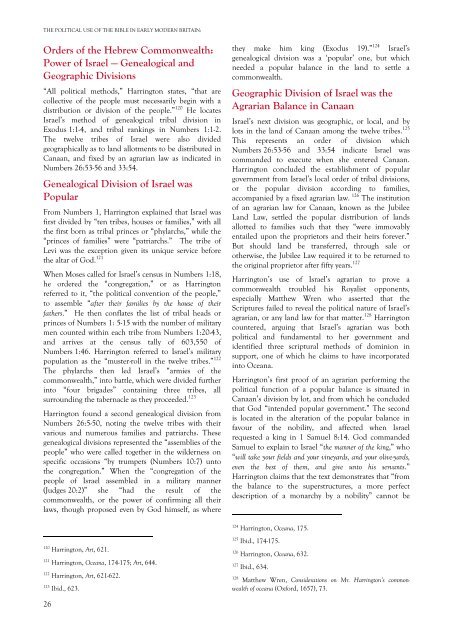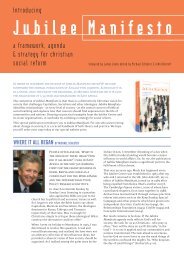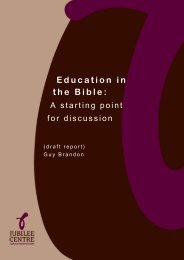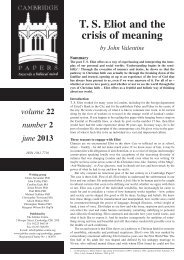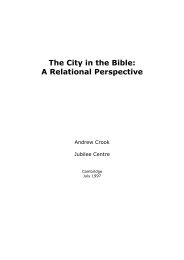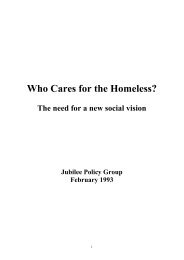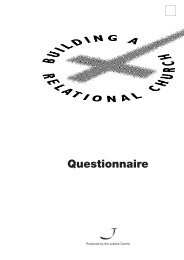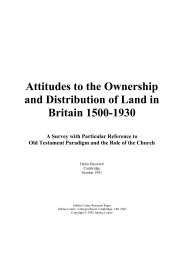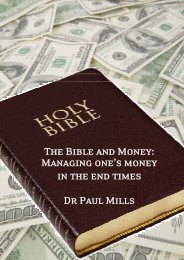Report Template - Jubilee Centre
Report Template - Jubilee Centre
Report Template - Jubilee Centre
You also want an ePaper? Increase the reach of your titles
YUMPU automatically turns print PDFs into web optimized ePapers that Google loves.
THE POLITICAL USE OF THE BIBLE IN EARLY MODERN BRITAIN:<br />
Orders of the Hebrew Commonwealth:<br />
Power of Israel — Genealogical and<br />
Geographic Divisions<br />
“All political methods,” Harrington states, “that are<br />
collective of the people must necessarily begin with a<br />
distribution or division of the people.” 120 He locates<br />
Israel’s method of genealogical tribal division in<br />
Exodus 1:1-4, and tribal rankings in Numbers 1:1-2.<br />
The twelve tribes of Israel were also divided<br />
geographically as to land allotments to be distributed in<br />
Canaan, and fixed by an agrarian law as indicated in<br />
Numbers 26:53-56 and 33:54.<br />
Genealogical Division of Israel was<br />
Popular<br />
From Numbers 1, Harrington explained that Israel was<br />
first divided by “ten tribes, houses or families,” with all<br />
the first born as tribal princes or “phylarchs,” while the<br />
“princes of families” were “patriarchs.” The tribe of<br />
Levi was the exception given its unique service before<br />
the altar of God. 121<br />
When Moses called for Israel’s census in Numbers 1:18,<br />
he ordered the “congregation,” or as Harrington<br />
referred to it, “the political convention of the people,”<br />
to assemble “after their families by the house of their<br />
fathers.” He then conflates the list of tribal heads or<br />
princes of Numbers 1: 5-15 with the number of military<br />
men counted within each tribe from Numbers 1:20-43,<br />
and arrives at the census tally of 603,550 of<br />
Numbers 1:46. Harrington referred to Israel’s military<br />
population as the “muster-roll in the twelve tribes.” 122<br />
The phylarchs then led Israel’s “armies of the<br />
commonwealth,” into battle, which were divided further<br />
into “four brigades” containing three tribes, all<br />
surrounding the tabernacle as they proceeded. 123<br />
Harrington found a second genealogical division from<br />
Numbers 26:5-50, noting the twelve tribes with their<br />
various and numerous families and patriarchs. These<br />
genealogical divisions represented the “assemblies of the<br />
people” who were called together in the wilderness on<br />
specific occasions “by trumpets (Numbers 10:7) unto<br />
the congregation.” When the “congregation of the<br />
people of Israel assembled in a military manner<br />
(Judges 20:2)” she “had the result of the<br />
commonwealth, or the power of confirming all their<br />
laws, though proposed even by God himself, as where<br />
they make him king (Exodus 19).” 124 Israel’s<br />
genealogical division was a ‘popular’ one, but which<br />
needed a popular balance in the land to settle a<br />
commonwealth.<br />
Geographic Division of Israel was the<br />
Agrarian Balance in Canaan<br />
Israel’s next division was geographic, or local, and by<br />
lots in the land of Canaan among the twelve tribes. 125<br />
This represents an order of division which<br />
Numbers 26:53-56 and 33:54 indicate Israel was<br />
commanded to execute when she entered Canaan.<br />
Harrington concluded the establishment of popular<br />
government from Israel’s local order of tribal divisions,<br />
or the popular division according to families,<br />
accompanied by a fixed agrarian law. 126 The institution<br />
of an agrarian law for Canaan, known as the <strong>Jubilee</strong><br />
Land Law, settled the popular distribution of lands<br />
allotted to families such that they “were immovably<br />
entailed upon the proprietors and their heirs forever.”<br />
But should land be transferred, through sale or<br />
otherwise, the <strong>Jubilee</strong> Law required it to be returned to<br />
the original proprietor after fifty years. 127<br />
Harrington’s use of Israel’s agrarian to prove a<br />
commonwealth troubled his Royalist opponents,<br />
especially Matthew Wren who asserted that the<br />
Scriptures failed to reveal the political nature of Israel’s<br />
agrarian, or any land law for that matter. 128 Harrington<br />
countered, arguing that Israel’s agrarian was both<br />
political and fundamental to her government and<br />
identified three scriptural methods of dominion in<br />
support, one of which he claims to have incorporated<br />
into Oceana.<br />
Harrington’s first proof of an agrarian performing the<br />
political function of a popular balance is situated in<br />
Canaan’s division by lot, and from which he concluded<br />
that God “intended popular government.” The second<br />
is located in the alteration of the popular balance in<br />
favour of the nobility, and affected when Israel<br />
requested a king in 1 Samuel 8:14. God commanded<br />
Samuel to explain to Israel “the manner of the king,” who<br />
“will take your fields and your vineyards, and your olive-yards,<br />
even the best of them, and give unto his servants.”<br />
Harrington claims that the text demonstrates that “from<br />
the balance to the superstructures, a more perfect<br />
description of a monarchy by a nobility” cannot be<br />
124<br />
Harrington, Oceana, 175.<br />
120<br />
Harrington, Art, 621.<br />
121<br />
Harrington, Oceana, 174-175; Art, 644.<br />
122<br />
Harrington, Art, 621-622.<br />
123<br />
Ibid., 623.<br />
125<br />
Ibid., 174-175.<br />
126<br />
Harrington, Oceana, 632.<br />
127<br />
Ibid., 634.<br />
128<br />
Matthew Wren, Considerations on Mr. Harrington’s commonwealth<br />
of oceana (Oxford, 1657), 73.<br />
26


